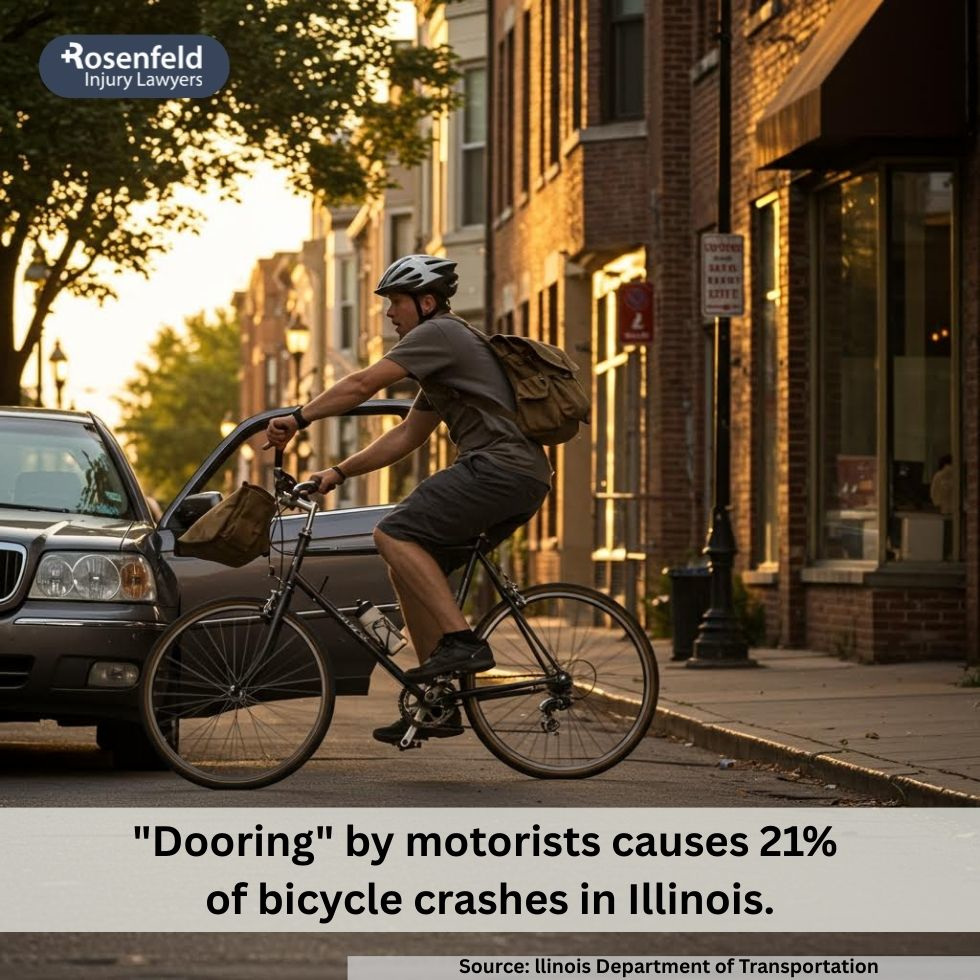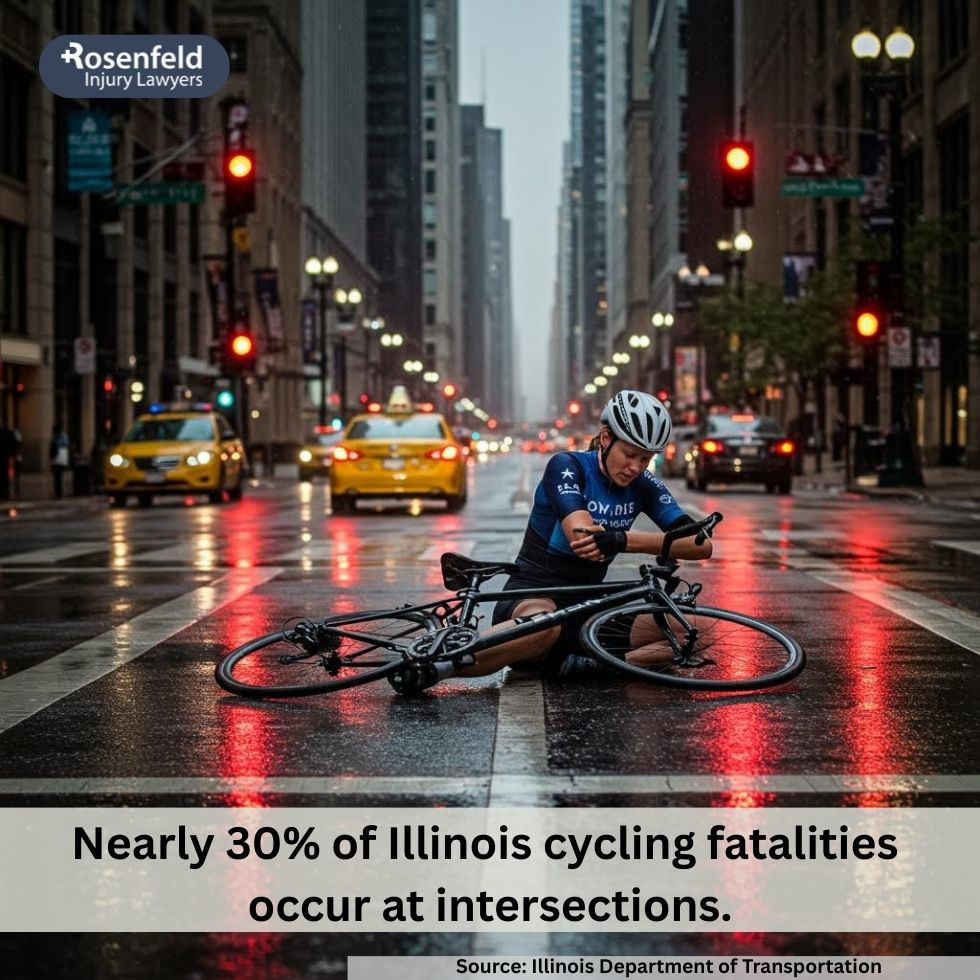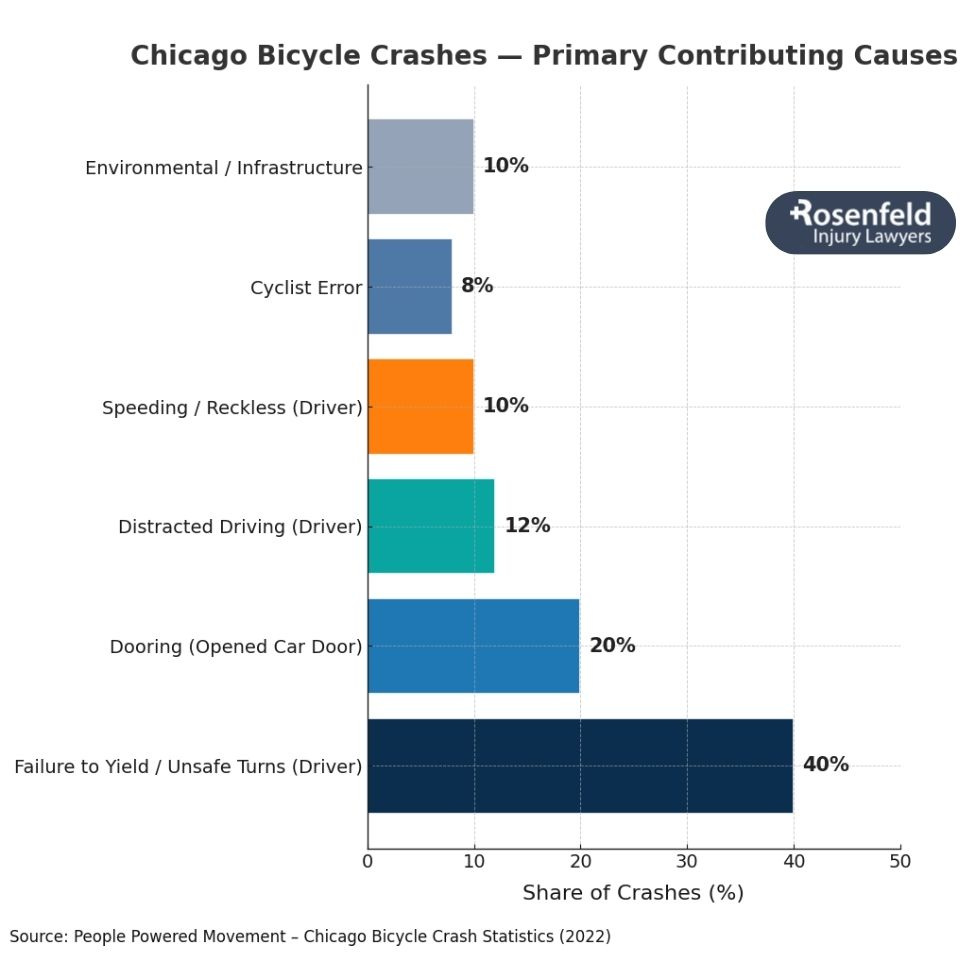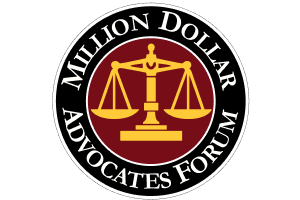- 24/7 Free Consultation: (888) 424-5757 Tap Here To Call Us
Common Causes of Bicycle Accidents in Chicago

Common Causes of Bicycle Accidents in Chicago underscore the dangers of this popular mode of transportation and recreation. It’s more important than ever that cyclists and other road users understand the causes of bicycle accidents and how victims can seek compensation and support.
Understanding the types of injuries sustained and preventative measures will reduce the risks. By understanding the factors why most bike accidents occur, cyclists can use safety precautions to protect themselves and seek justice if they are involved in bicycle crashes.
If you’ve been injured in a cycling accident, contact an experienced Chicago bicycle accident lawyer from our team to discuss your legal rights.
Bicycle Accident Statistics
Bicycle accident statistics show that in the USA, a total of 1,084 bicyclists were killed in crashes with motor vehicles in 2022. In Illinois, only one-third of fatal bicycle accidents occurred outside of the Chicago metropolitan area, showing that Cook County is especially hazardous for cyclists.
Cyclists suffer from serious injuries each year. Illinois has not just seen an increase in cycling accidents but an increasing number of emergency room visits and hospitalizations. Sadly, 145 cyclists suffered incapacitating injuries in the Chicagoland area in 2022, with 826 suffering non-incapacitating injuries.
This alarming level of incidents underscores the importance of addressing the causes of bicycle accidents and implementing strategies to prevent them.

Common Types of Bicycle Injuries
Bicycle accidents can result in a wide range of injuries, varying in severity depending on the circumstances of the crash. Some of the most common injuries seen by our Chicago bicycle accident attorneys include:
- Head Injuries: Traumatic brain injuries are one of the most severe consequences of a bicycle accident. Even with a helmet, cyclists can suffer from concussions, skull fractures, and other head trauma.
- Fractures: Broken bones are common, particularly in the arms, legs, and collarbones, as cyclists often try to brace themselves during a fall.
- Spinal Cord Injuries: A severe crash can lead to damage to the spinal cord, resulting in partial or complete paralysis.
- Lacerations and Abrasions: Road rash and deep cuts can occur when cyclists touch the pavement or other hard surfaces.
- Internal Injuries: Blunt force trauma from a collision can cause internal injuries, including damage to organs, which may require emergency medical treatment.
- Soft Tissue Injuries: These include sprains, strains, and tears in muscles, ligaments, and tendons, which can lead to long-term pain and mobility issues.
Prompt medical attention is essential after an accident, as some injuries may not be immediately apparent.
Common Causes of Bicycle Accidents
Bicycle accidents happen for various reasons, often involving a combination of human, environmental, and vehicle-related factors. Understanding these causes can help prevent future accidents and inform cyclists how to protect themselves.
Human Factors in Bicycle Accidents
Unfortunately, humans are not robots and are prone to error. Human error is thus a leading cause of bicycle accidents. Whether it’s a mistake made by the cyclist or another road user, these errors can have devastating consequences.
Rider Error
Riders make a variety of errors, which can lead to crashes. These include:
- Riding Under the Influence: Alcohol and drugs impair judgment and reaction times, making it dangerous to operate a bicycle. It can also lead to a charge of reckless conduct under Illinois law (§720 ILCS 5/12-5). A Chicago bicycle accident attorney can help you if you’re involved in a crash under these circumstances.
- Disregarding Traffic Signals: Failure to obey traffic signals and signs is one of the most common causes of bicycle accidents. Cyclists must adhere to the same road rules as motorists to ensure their safety and the safety of others as outlined in Chicago Municipal Code §9-52-010. They must utilize a bike lane if one is available.
- Failing to Wear a Helmet: While not a direct cause of accidents, failing to wear a helmet increases the severity of injuries in a crash. Helmets are essential for protecting against head injuries and should always be worn.
Distractions
Distractions are a significant factor in many bicycle accidents. Distracted cyclists are less likely to notice hazards or react quickly to avoid collisions. Texting, calling, or using a phone while riding can take a cyclist’s attention away from the road, increasing the risk of an accident.
Lack of Experience
One of the common causes of bicycle accidents is a simple lack of experience. New or infrequent cyclists may not be familiar with traffic rules, road conditions, or how to handle their bikes in challenging situations. Education and practice are crucial for safe riding.

Environmental Factors in Bicycle Accidents
Environmental factors like road conditions and weather can also significantly affect bicycle accidents.
Road Conditions
Poor road conditions are a significant hazard for cyclists. Potholes and cracks are hazardous for cyclists, as hitting a pothole can throw a rider off their bike. Unfortunately, even protected bike lanes may not make it easy to file a lawsuit, as Alave v. City of Chicago claims that cyclists are not intended road users.
Debris on the road, such as gravel, glass, or branches, can cause a bicycle tire to slip or puncture, leading to severe injuries. While the local government and councils should maintain roads, remaining vigilant toward these potential hazards is essential.
Weather Conditions
Adverse weather conditions can make cycling more dangerous. Rain, snow, and fog can reduce visibility, make roads slippery, and increase the likelihood of accidents.
Wet roads can cause tires to lose traction, making it difficult for cyclists to stop or turn safely. Cyclists should ride cautiously and consider using tires designed for wet conditions.
Snow and ice create extremely hazardous conditions for cyclists. It is often best to avoid riding in such weather, but if necessary, cyclists should use caution and consider equipping their bikes with appropriate tires.
Fog reduces visibility for cyclists and drivers, increasing the risk of collisions. Not seeing a cyclist is one of the most common causes of bicycle accidents in areas prone to fog. In foggy conditions, cyclists should use lights and wear bright or reflective clothing.
Lack of Infrastructure
Inadequate bicycle infrastructure, such as needing a bike path available, is a significant factor in many accidents. Cyclists must share the road with motor vehicles without safe places to ride, increasing the risk of fatal bicycle accidents.
Unsafe crossings or a lack of bike lanes can make for dangerous cycling routes. Though you can manage the risks to some degree by cycling safely, avoiding overly dangerous routes altogether is advisable since you can’t control the behavior of other road users.
Dangerous Intersections in Chicago
While Chicago has added a number of protected bike lanes, this is still not enough to ensure cyclist safety. Some of the most dangerous intersections in the Windy City include the following.
- Milwaukee and Kostner – Located near Schurz High School, this area has significant foot and motor vehicle traffic, making crashes more likely.
- Lincoln and Clark – This area near Lincoln Park Zoo is popular with tourists who may not be very familiar with the streets.
- Irving Park, Cicero, and Milwaukee: The Six Corners area in Portage Park has confusing intersections and high traffic volumes, causing serious accidents.
- North, Damen, and Milwaukee: Each of these streets in the Wicker Park area has very high traffic, so when they come together at this intersection, cyclist fatalities are more likely.

Vehicle Factors in Bicycle Accidents
The lion’s share of bike accidents involve a motor vehicle. In 2022, of the 1360 bicyclist deaths reported in the USA, 928 involved a motor vehicle. This is due to various factors, including driver error, poor vehicle design, and a lack of awareness.
Careless Drivers
Negligent drivers can pose a severe threat to cyclists. Common driver mistakes include speeding, distracted driving, and failing to give way.
Driver error is one of the most dangerous causes of bicycle accidents. Distracted drivers are less likely to see these smaller vehicles, which can force cyclists to make dangerous defensive maneuvers. In some cases, cyclists are victims of road rage.
Vehicle Design
The design of motor vehicles can also contribute to bicycling accidents, particularly regarding visibility. Larger vehicles have significant blind spots that can obscure a cyclist from view, such as when trying to pass through stop signs along Halsted Road. You must know this as a cyclist to factor it into your positioning.
Lack of Awareness
Many drivers are unaware of cyclists on the road. For example, they may open car doors in front of oncoming cyclists, causing dooring accidents. The last few years have seen a steep increase in public awareness campaigns and education to ensure drivers understand cyclists’ rights and how to share the road safely.
Bicycle Accident Prevention Strategies
Preventing bicycle accidents requires a multifaceted approach involving education, infrastructure improvements, and traffic law enforcement, such as the following.
Rider Education
One of the most effective things a cyclist can do to avoid a bike accident is to educate themselves. Cyclists must be taught safe riding practices, including obeying traffic laws, handling their bikes in various conditions, and protecting themselves on the road.
Many local groups, like Active Transportation Alliance and Bike Lane Uprising, offer road safety courses. and though it might seem tedious or overly cautious, it can significantly reduce risks further down the line.
Infrastructure Improvements
Safe bicycle infrastructure, such as dedicated bike lanes, protected bike paths, and bike-friendly intersections, significantly reduces accidents.
Though bicyclists are not likely to have the permission or resources to create infrastructure, advocating and campaigning can be an effective tool in persuading the Chicago Department of Transportation and district governments to invest in bike friendliness.
Enforcement of Traffic Laws
In reality, much stricter enforcement of traffic laws is necessary to protect cyclists.
This includes cracking down on speed limit violations, distracted driving, and other dangerous behaviors that put cyclists at risk. Law enforcement agencies should also educate drivers about sharing the road with cyclists.
Public Awareness Campaigns
Raising public awareness about cyclist safety can go a long way toward preventing accidents. Public campaigns help the general public understand cyclists’ challenges and encourage them to be more cautious and considerate.
How Can Bicyclists Protect Themselves?

While it is essential to address the broader factors that might contribute, cyclists should take every possible step to protect themselves from experiencing a bicycle accident.
Wearing a helmet, using lights and reflective gear to improve visibility, and staying alert are critical measures for staying safe on the road. Additionally, cyclists should be familiar with their rights and know how to seek legal help if involved in an accident.t.
At Rosenfeld Injury Lawyers, we understand the devastating impact bicycle accidents can have on your life. If you or a loved one has been injured in a bicycle accident, our experienced team of Chicago bike accident lawyers is here to help you navigate the legal process and ensure you receive the compensation you deserve.
Call an experienced attorney at (888) 424-5757 or contact us online.
All content undergoes thorough legal review by experienced attorneys, including Jonathan Rosenfeld. With 25 years of experience in personal injury law and over 100 years of combined legal expertise within our team, we ensure that every article is legally accurate, compliant, and reflects current legal standards.







